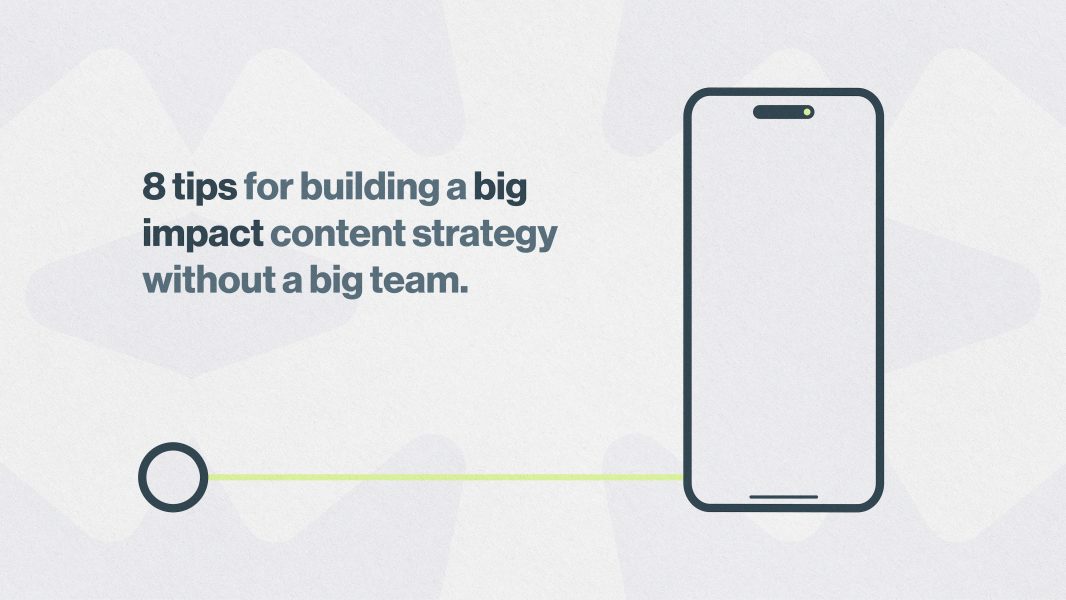8 tips for building a big impact content strategy without a big team.
Topic
Content Strategy10 mins read

When you’re running a start-up or scaling a growing business, content marketing can feel like one of those things you “should” be doing, but rarely have the time, team or tools to do properly.
You’ve got a product to launch, customers to win and probably more tabs open than any browser was designed for. So how do you build a smart, sustainable content strategy without a dedicated team of copywriters, strategists and designers?
Good news: it is possible. When you don’t have the luxury of bloated processes or over-planned calendars, you’re forced to focus on content that delivers real value and real results. Here’s how to do exactly that.
1. Start with strategy, not output.
Before you post a single thing, take a step back. Content strategy isn’t just about blog frequency or what to post on LinkedIn. It’s about who you’re trying to reach, what action you want them to take and how content can help get them there.
Ask yourself:
- Who are our primary audiences or audience personas?
- What problems are they facing that we can help solve?
- Where do they go for insight or information?
- What are the key business goals content should support (e.g. lead generation, brand awareness, investor visibility)?
Even a single-page plan that outlines your goals, audiences and content pillars can save you hours of scattergun effort later on.
2. Pick your platforms (and stick to them).
Trying to be everywhere is a fast-track to burnout. Instead, choose 1–2 key channels where your audience already spends their time and commit to showing up consistently.
- LinkedIn is often the best platform for B2B start-ups and founders
- Instagram or TikTok may work better for lifestyle-led consumer brands
- Email (via newsletters) is hugely underrated for building owned audience relationships.
Focus on doing a few things well, and doing them consistently, rather than trying to keep up with every trend.
3. Create content you can repurpose.
You don’t need to reinvent the wheel every week. Instead of chasing new ideas from scratch, build pillar content – meaty, valuable content that can be sliced, diced and reused across multiple platforms.
For example:
- Turn a blog post into 3-5 LinkedIn posts
- Break down a webinar or podcast into quote cards, short videos or carousels
- Use customer FAQs to fuel multiple how-to or top tips articles.
This “create once, distribute many” mindset is the most efficient way to stretch content when time and team size are tight.
4. Use AI & tools (but don’t lose the human touch).
Tools like ChatGPT, Grammarly, Canva and Notion can help solo marketers or founders punch above their weight. Use them to:
- Generate content ideas or outlines
- Draft rough versions of social posts or blogs
- Create visual assets quickly and easily
- Manage all your content calendars in one place.
But don’t fall into the trap of publishing robotic or generic content. Use AI for efficiency, but always bring your brand’s voice, tone and point of view into the final edit. Audiences respond to authenticity, not AI-written fluff.
5. Build a bank of evergreen content.
When you’re operating at speed, not every week will be content-rich. That’s where evergreen content comes in.
Evergreen content is useful, long-lasting material that stays relevant. Think:
- How-to guides and whitepapers
- Explainers for industry terms
- Customer onboarding tips
- Founder stories or vision pieces
- Product FAQs
Building a backlog of this content gives you something to post during busy weeks or when creative inspiration runs dry. It also boosts your SEO and can bring in steady website traffic over time.
6. Get input from across the business.
You don’t always need a specialist content team to create good content. Tap into the brains around you:
- Ask your sales team what prospects are asking
- Interview your product team about upcoming features
- Turn customer feedback into case studies or testimonials
- Share behind-the-scenes snapshots from ops or delivery.
Not only does this reduce the content creation burden on one person, it also makes your content richer and more diverse.
7. Test and learn - but keep it lean.
You don’t need fancy analytics dashboards or endless A/B testing. But you do need to track what’s working.
- Keep an eye on post engagement (likes, comments and clicks)
- Monitor your web traffic and top-performing pages
- Use UTMs or basic Google Analytics to track content-driven conversions.
Over time, patterns will emerge: certain topics, formats or channels will clearly outperform others. Use that data to double down on what works and ditch what doesn’t.
8. Don’t chase perfection.
Here’s the truth: most people aren’t paying as much attention to your content as you are. So don’t let perfectionism become procrastination.
Done is better than perfect. A post that gets 80% of the way there is more valuable than an idea that never sees the light of day. Focus on showing up consistently with value — not on crafting the Mona Lisa of blog posts. We touch on this more in our recent blog about the importance of momentum in marketing.
Final word (and a friendly offer).
You don’t need a big team to build a smart, effective content strategy – just the right approach, a few tool, and a bit of consistency. But if you’re short on time, headspace or confidence, we’re here to help.
We’ve got plenty of experience working with start-ups and scale-ups to craft lean, powerful content strategies and create standout content that drives results, without the need for in-house teams or huge budgets.
Need a hand? Get in touch. We’d love to help you build something brilliant.

